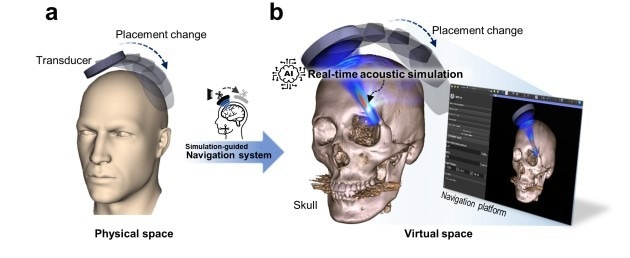By concentrating ultrasonic energy on certain millimeters of the brain, even deep areas, focused ultrasound technology offers a non-invasive therapy option for neurological problems that does not require opening the skull. Due to its ability to limit damage to surrounding healthy tissue and lessen side effects including infections and problems, it has been used in the treatment of several incurable brain diseases, including depression and Alzheimer’s disease.
 Simulation-Guided Navigation Systems. Image Credit: Korea Institute of Science and Technology
Simulation-Guided Navigation Systems. Image Credit: Korea Institute of Science and Technology
Its use has been restricted thus far, though, as it is challenging to represent the real-time ultrasound wave distortion brought on by the various patient skull shapes.
An acoustic simulation technology based on generative AI has been developed by a research team led by Dr. Kim, Hyungmin of the Bionics Research Center at the Korea Institute of Science and Technology (KIST). This technology can be used to predict and correct the distortion of the ultrasound focus position caused by the skull during focused ultrasound therapy in real time.
Currently, there is no clinical validation for the application of AI simulation models in the field of non-invasive focused ultrasound therapeutic technologies.
Navigation systems based on medical images collected before treatment are presently used to forecast the location of the invisible acoustic focus, which offers information about the relative position of the patient and the ultrasound transducer.
They are limited, however, by their failure to take into consideration the distortion of ultrasound waves caused by the skull, and while various simulation techniques have been created to make up for this, they nevertheless require crucial computational time, making them difficult to apply in actual clinical practice.
Using an artificial intelligence model based on a generative adversarial neural network (GAN), a deep learning model frequently used for image creation in the medical area, the study team created a real-time focused ultrasound simulation technology.
The technology shows an average maximum acoustic pressure error of less than 7% and a focal position error of less than 6mm, both of which are within the error range of existing simulation technologies, boosting the potential of clinical application. It also shortens the update time of three-dimensional simulation information reflecting changes in ultrasonic acoustic waves from 14 seconds to 0.1 seconds.
To test the functionality of the developed technology and quickly implement it in actual clinical settings, the study team also created a medical image-based navigation system. The system was able to forecast the location of the ultrasound energy and focus within the skull during focused ultrasound therapy, and it can provide real-time acoustic simulations at a rate of 5 Hz based on the position of the ultrasound transducer.
Due to the long computation period, the ultrasonic transducer had to be carefully positioned in a pre-planned place to use the simulation findings previously. However, with the newly created simulation-guided navigation system, the ultrasound focus can now be adjusted depending on real-time acoustic simulation findings.
It is projected to increase the precision of focused ultrasound and offer safe therapy for patients in the future by being able to respond rapidly to unforeseen events that could happen during the treatment process.
As the accuracy and safety of focused ultrasound brain disease treatment has been improved through this research, more clinical applications will emerge. For practical use, we plan to verify the system by diversifying the ultrasound sonication environment, such as multi-array ultrasound transducers.
Dr. Kim Hyungmin, Principal Researcher, Bionics Research Center, Korea Institute of Science and Technology
Under the National Research Council of Korea’s Creative Convergence Research Project (CAP-18014-000), the Ministry of Science and ICT (Minister Lee Jong-ho) provided funding for this study. On October 14th, 2023, the study’s findings were published in the prestigious international journal NeuroImage (ranked 3.6% in JCR).
Journal Reference:
Park, T. Y., et. al. (2023) Real-Time Acoustic Simulation Framework for tFUS: A Feasibility Study Using Navigation System. NeuroImage. doi:10.1016/j.neuroimage.2023.120411